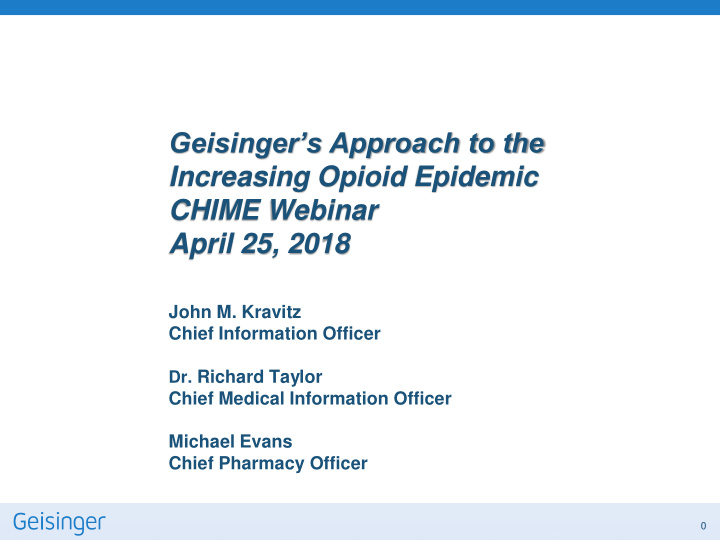



Geisinger’s Approach to the Increasing Opioid Epidemic CHIME Webinar April 25, 2018 John M. Kravitz Chief Information Officer Dr. Richard Taylor Chief Medical Information Officer Michael Evans Chief Pharmacy Officer 0
About Geisinger • 12 hospitals and 700 clinics in Pennsylvania and New Jersey • 2,400 employed physicians and ~4,000 affiliated physicians • Serving ~3 million patients • Health plan = ~600k subscribers 1 1
The Opioid Epidemic in Pennsylvania • 2016: 4,642 drug-related deaths in PA • 85% (3,946) involved opioids • 25% (1,161) involved prescription opioids • The counties Geisinger services are among the highest overdose deaths per capita in the state Source: Analysis of Overdose Deaths in Pennsylvania, 2016, DEA Philadelphia Division and the University of Pittsburgh, July 2017 2 2
Geisinger’s Response to Prescription Opioid Abuse Addressing prescription opioid abuse is a multifaceted, holistic effort – there is no single “silver bullet”! Geisinger initiatives: • Encourage effective, non-opioid therapies • Leverage the Pennsylvania state PDMP • Link provider dashboard to Epic • Document findings in patient’s medical record • Integrate data from our pain application into the dashboard and the patient’s medical record • Enable electronic prescribing for controlled substances (EPCS) 3 3
Geisinger Slashes Prescriptions for Opioids in Half Using Provider Dashboard • Opioid prescriptions per month reduced by an average of 60,000 to 31,000. • Provider dashboard linked to Epic. • Pennsylvania mandates provider usage of PDMP (Prescription Drug Monitoring Program), state run electronic database that tracks opioid prescribing. • Findings documented in patient’s medical record. • Pain app – Data integrated into dashboard and patient’s medical record. 4
Overdose Deaths thru 2015 - Opioids 5
Geisinger Study Not Finding Opioids Helpful in Treating Chronic Pain 6
Geisinger Study Finds Opioids Not Helpful in Treating Chronic Pain Side effects of chronic opioid therapy include: • Risk of addiction and depression • Sleep disordered breathing • Impaired wound healing and infections • Cognitive impairment, falls, fractures and death Effective, non-opioid therapies include: • Chronic pain rehabilitation and exercise • Cognitive behavioral therapies • Acupuncture, yoga or tai chi 7
Patterns of health care use and cost before and after opioid overdose 8
Patterns of health care utilization and cost before and after opioid overdose: findings from 10-year longitudinal health plan claims data • Study involved 942 opioid OD patients with an average GHP enrollment period of 41.4 months were identified. • ED visit rates rose rapidly starting around 19-24 months prior to the opioid OD date. • Acute inpatient admission rates and total medical cost also rose rapidly starting around 12 months prior. • After the OD date, the utilization rates and cost declined but tended to remain above those of the pre-OD period. 9
Electronic Prescribing Controlled Substances 10
Challenges • Prescription errors and inaccuracies • Prescription forgeries • Lack of patient satisfaction • Long patient wait times • Convoluted ordering workflows • Manual paper ordering process 11
Calculating Cost Savings of EPCS Domain Before EPCS With EPCS Assumption Cost/Savings (year 1) Cost/Savings (ongoing) EPCS cost $0 $400,000 $75k/year ongoing $400,000 $75,000 Reduce by 50% Call Center 660k calls/year 330k calls/year ($920,700) ($920,700) $2.79/call Reduce by 50% Diversion control 6 FTE RN 3 FTE RN ($225,000) ($225,000) $75k/RN $7/provider/min 3 min/script for 30 sec/script for Provider ($210,000) ($210,000) controlled med controlled med $350k/MD $2/LPN/min 5 min/script for LPN n/a ($60,000) ($60,000) controlled med $50k/LPN NET ($1,015,700) ($1,340,700)/year 12
e-Prescribing System Current Statistics • 74% of controlled medications being ePrescribed • 82% Outpatient adoption • 20% Inpatient adoption • 126 clinics at 100% ePrescribing of controlled substances • 1661 or 62% of Geisinger employed providers are identity proofed 13
Questions 14
Following our presentation, please reference KnowledgeHub. There you will find: • An archive of this presentation • Case study provided by CHIME • Articles and other resources the Opioid Task Force has been sharing KnowledgeHub is a great resource for solutions shared by colleagues. Contribute documents and find others! https://knowhubcentral.org 15
Recommend
More recommend